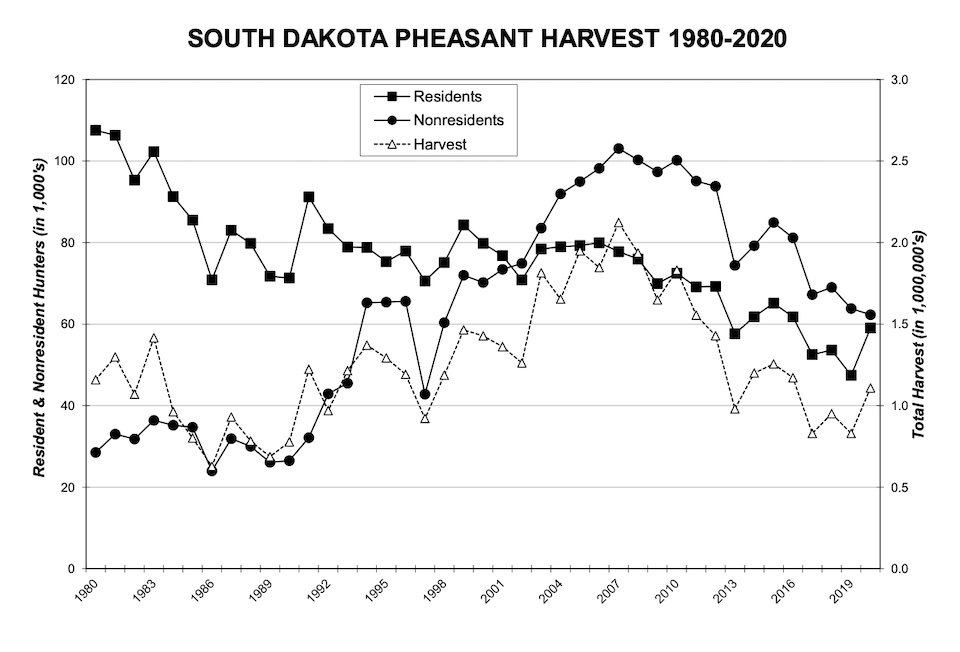The Governor and Game Fish and Parks last week posted the final numbers for the Nest Predator Bounty Program. In our third year of offering cash for dead critter tails, 2,773 hardy outdoorspeople killed and detailed 53,642 furry mammals. 29% of the killers were kids, up from 16% in 2020. The victims included the following, in raw numbers (and percentage of kill):
- raccoons: 40,900 (76%)
- striped skunk: 7,100 (13%)
- opossum: 4,900 (9.1%)
- red fox: 438 (0.8%)
- badger: 417 (0.8%)
When science failed to support Governor Kristi Noem’s pheasant-boosting rationale for starting the trapping program in 2019, the state shifted to saying the primary objective of the Nest Predator Bounty Program is to encourage youth to engage in outdoor activities. But now Governor Kristi Noem claims, without elaboration, “The strong 2020 pheasant season proved the success of the program….” Game Fish and Parks figures that hunters shot 30% more state birds in the 2020 hunting season than they did in 2019. But GF&P also gave hunters much more time to pursue the wily ringneck. The 2019 pheasant season ran 83 days, including the three resident-only days in October. In 2020, GF&P stretched the season to 110 days. GF&P also moved the starting time for hunting during the first week from noon to 10 a.m., providing effectively two more days worth of time in the field. The 2020 pheasant season thus gave hunters 35% more time to bag their birds.
And even with all that extra time, the pheasant harvest was still lower than it was in 26 of the 39 seasons immediately preceding the Nest Predator Bounty Program:

Calling the 2020 pheasant harvest numbers “strong” takes a very narrow view of historical data. Saying those numbers “prove” the “success” of the Nest Predator Bounty Program ignores the extended season hunters enjoyed last fall and winter. That claim also ignores the fact that we counted and killed fewer pheasants in 2019 after the first run of the Nest Predator Bounty Program, then killed more pheasants in 2020 after the second year of the program with lower bounties per tail resulted in fewer raccoons and friends killed.
We have two years of data now on state-subsidized trapping and pheasant harvests. None of that data establishes a clear link between the former and the latter.
Oof, that is a terrible chart.
It looks like ending the brood count didn’t reverse declines in out of state hunters. However, recruitment of resident hunters went up, so the extended season apparently helped. That means the increased harvest numbers are almost wholly at the hands of residents. That’s not so bad to me.
Hunters are going to be paying closer attention to field reports like what’s published in Pheasants Forever without the state conducting brood counts. I’ve noticed PF hasn’t put the same polish on South Dakota’s numbers as the Governor has.
Perhaps the governor forgot that after a record harsh winter it rained “every stinking day” in 2019 which isn’t exactly the best for young pheasant broods. Good grief! I guess she wasn’t out trying to raise crops or feed livestock so it’s easier to forget.
Admit it, South Dakota.
Wild pheasant tastes like shoe leather boiled in cream of mushroom soup.
Just watch where you step, Cory.
Well…Pheasant hunting is a big deal to me and its a sad day when out of state hunters (mostly pay to hunt people) bag the same number of birds as South Dakota residents. How many pheasants live in our weed patches and wetlands is mostly a product of weather and the existing biomass of good habitat available to the birds. Killing 40,000 raccoons and 5000 possums only insures that the possums will probably increase and replace the missing coons in their niche.Killing close to a thousand red fox and badgers is just conservation blasphemy. Remember, please, wildlife belong to everyone.
I should point out I’m not totally opposed to trapping, especially by young people who are enjoying the outdoor life. I am very opposed to any notion that focusing on these species will have any impact on pheasant numbers. It’s just more half baked, ill considered, non scientific wildlife policy.
I would add, that if we must put a bounty on any animal, put one on feral cats who kill more birds and baby pheasants than many other species of wild animal.
I guess as long as there is something to trap and shoot the gun nuts of S.D. are in high heaven. I know they just want to kill and don’t even eat the pheasants that are not indigenous to the state. It’s a “kill culture” we’re raising in this part of the world. Get a gun or a trap and just kill. It’s sick.
That’s what happens when you give little boys guns to play with as if they are toys. Learned behaviors that are sick.
I’ve lived in S.D. my whole life and nobody I know eats pheasant. They save it for wild game feeds or give it to people from out of state. They just want to shoot it for fun and bonding oh and MONEY.
I was brought up to respect guns and to use them for food only. We never needed anything for protection. We did not waste anything, especially life.
To kill for the sake of killing is wrong Kristi Noem.